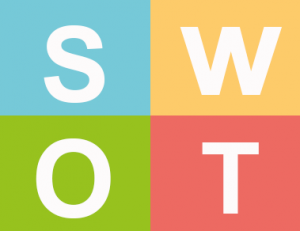Flashback to November 1995 – Microstar Software: Try the SWOT method

Great new products often grow from a solution looking for a problem. Match your strengths to the problems you find to create winning opportunities.
Try the SWOT method. Here’s an example:
At Microstar Software, Peter Jordan and Shaun McEwan (now CEO and COO, respectively) were on a venture capital tour several years ago. Their new product concept was the “hottest idea in interactive graphics for international communications.”
Although venture capital audiences were not impressed, the trip lead to many new ideas. They learned about new trends in standardizing document formats using “SGML” – new terrain for Microstar, but not a technical stretch. In fact, SGML fit the technology Microstar already had. They knew they could do it, and do it better than current players!
Opportunity Knocks: Play it from strength, Sam.
The Microstar team said “SGML is too complicated for the users.” That was the opportunity knocking. Document type definitions look like a tree – why not display them graphically as a tree, and let the users manipulate the tree?
Opportunity comes from recognizing how several trends will work together:
- The “Information Highway” and the Internet were emerging – interchanging documents was a growing need.
- Business people with document portability problems would be a huge market.
- SGML was one of two strong possibilities in the movement to international standards.
- Unadorned SGML was too complex for mass market use, and required highly trained specialists in order to set up a collection of documents.
Microstar brought certain strengths to the table:
- Understanding and expertise in usable computer graphics on the international scene.
- Experience dealing with other countries, on both political and technical levels.
- Experience with international languages at the technical level (including far eastern languages).
- “Open design” principals of product development.
The real strength was the expertise built up in advance of others operating in that segment, not the new product concept taken to the venture people.
There were some weaknesses; not much marketing experience and no experience with shrink wrap software.
Consideration of all factors led to the development and launch of NEAR & FAR, a product for graphical creation of SGML Document Type Definitions. It is rated far and away the best in its field.
The Lesson – Try The SWOT Method
This is a brainstorming and reflection process. Get your planning team (usually 3 to 4 people) together with some flip-chart paper or a big white board. Then:
1. List ideas under four topics: Strengths, Weaknesses, Opportunities, and Threats (SWOT). Everyone should be present for the entire meeting; all ideas are good ideas. In most cases it will be appropriate to do this for both the “company” and the “product”. List who in the marketplace would know where your opportunities may lie.
2. Review your lists to determine the top priorities. Get each participant to pick their ‘top two’ strengths, ‘top two’ opportunities, and so on. A pattern and consensus will emerge. This will define which items go onto your ‘short list’.
3. Consider ways to maximize key ‘strengths’ and exploit key ‘opportunities’. Also consider ways to compensate for ‘weaknesses’ and ‘threats’. A new path will emerge on how to characterize your unique opportunities, and how to hit the market.
Start today to use these techniques. The Microstar story shows the value of looking for opportunity, knowing your strengths, and putting the two together.
Do it right, do it now, and you too can play it again, Sam !
This article by Peter Fillmore, was originally published in MARKETECH in November 1995.



Follow Us
Follow us on LinkedIn for updates.